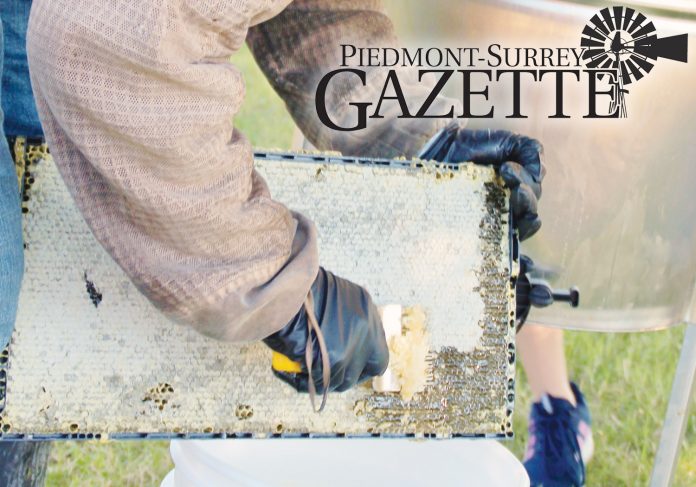
By Carol Mowdy Bond
Contributing Writer
A large group flocked to a Canadian County pasture on Saturday, September 5. Justin Scott, owner of Sweet Stingers Honey & Apiary, demonstrated the extraction of honey from honey bee hives. As well, area farmers and local entrepreneurs sold everything from baby chicks and ducks, quail eggs, honey, elderberry syrup, and garden produce, to homemade craft items.
Scott set up his equipment under a shade tree, and kept his smoker going in the back of his pickup truck. The smoker calmed down the bees.
Scott’s demonstration drew a crowd. And as he extracted the honey, he explained what he was doing.
Scott said, “The bees forage on wildflowers around the area. Then they return to the hive with their honey stomachs full of nectar from those flowers. While transporting the nectar, a protein enzyme in the honey stomach, called invertase, breaks the sucrose down into the two simple sugars, fructose and glucose. The forager honey bee transfers the nectar to another worker bee inside the hive. The worker bee then stores it inside one of the honey comb cells. Once inside the hive, the honey bees will begin to cure the honey. Curing involves bringing the nectar moisture level down to 18% or less. Nectar is 80 to 90% water, so this takes a lot of work and requires a lot of workers. Depending on the weather, humidity levels outside the hive, nectar source, and other conditions, curing honey can take weeks or longer. The honey bees cure the honey by rapidly fanning their wings across the honey combs full of nectar. This rapid fanning of the wings dehydrates the moisture in the nectar.”
Scott took a scraper and removed the caps or beeswax off the top of each screen of honey.
“When the moisture level reaches around 18%, the honey bees then cap the cells,” Scott said. “These capped cells are what we called capped honey. The cap is beeswax. Beeswax protects the honey from drawing moisture since honey is hyposcopic, meaning honey attracts water. Too much water in the honey will cause it to ferment. The fermented nectar or honey is not good for bees, so moisture levels need to be right. Bee keepers use a refractometer to measure the correct levels of moisture. If a beekeeper extracts with too high a level of moisture, the honey can ferment. We don’t want our customers to have fermented honey. So, we test our honey batches to make sure the moisture levels are low enough to not ferment.”
“The beeswax capping protects the honey, keeping it safe until the honey bees uncap it to eat during dearth (which is when there is no nectar or pollen coming into the hive because there are no flowers around), or when the bee keeper uncaps the honey frame to extract the golden, delicious honey,” Scott said.
Showing the frames, Scott noted that the honey in some frames was different in color than honey from other frames in the same hive. He explained that the bees had been going in different directions, to forage from different plants in different areas. As a result, the bees created different types of honey in the same hive.
After taking the cap or bees wax off each frame, Scott and his daughter Lexi placed the frame in a manual spinning extractor. When the spinner was full of frames, his son Lucas manually cranked the spinner. Scott’s wife, Melissa, said there are electric spinners, but they are quite pricey. When the spinning was complete, Scott opened the spinner’s spigot and the honey drained into a bucket.
“Once the honey is spun out in the extractor, the honey drains through a sieve of 600, 400, or 200 microns,” said Scott. “This is plenty large enough to allow all the pollens, tiny wax pieces, and all the beneficial parts of honey to flow through into the honey buckets. The purpose of the sieve is to take the bigger particles out, such as wax chunks, honey bee wings and legs, and other things people don’t want in their honey. We never filter our honey, nor do we ever heat our honey. Our honey is raw from hive to the bottle.”
Scott then moved the bucket of honey to another location, and opened the bucket’s spigot. As the honey flowed, he filled honey jars and capped the jars.
This demonstration is “how we extract every frame and how we bottle every jar of our raw, local Oklahoma honey,” Scott said.
“We keep all our honey, from each yard, city, town, and county, separate. We don’t mix them. That way people can have hyper local honey.”

Scott uses codes on the bottles, to indicate from which geographic area the jar of honey originated. Some people buy honey for health purposes, and others for taste. Either way, the geographic origin is often important to those who purchase honey.
Scott explained that the flavor, color, texture, and aroma of honey depend on which plants the bees gathered nectar from.
“Our honey changes flavor depending on the location,” Scott said. “If you want sweet honey, we have it. If you want something on the bolder side, we have it. Real, raw wildflower honey flavor profiles can be unique, and differ from areas even within the same town. They can even be different in the same apiary from hive to hive.”
“Real, raw honey can and will crystallize,” said Scott. “Crystallization of honey is completely normal, and does not damage the honey. In most cases, the crystallization process can be reversed by gently warming the honey to melt the crystals. We recommend placing the jars of crystallized honey on a sunny window sill, or bring it back to liquid by gently warming it over simmering water. Do not store honey in the refrigerator. Do not ever microwave honey. Heating honey too hot will kill all the beneficial aspects of honey.”
Scott, who adds no chemicals to his honey, said it takes around 560 honey bees to produce “every pound jar of our real, raw Oklahoma wildflower honey. And bees will fly the equivalent of more than once around the world to gather that one pound of honey. One worker bee will produce about 1/12 of a teaspoon in her entire lifetime.”
According to Scott, honey is primarily 38% fructose, 31% glucose, 17% water, 7% maltose, and small amounts of trisaccharides, other higher carbohydrates, sucrose, minerals, vitamins, and enzymes. There are trace amounts of vitamins including thiamin, riboflavin, niacin, pantothenic acid, vitamins B6, B12, C, A, D, E, and K, and folate. There are also trace amounts of minerals including calcium copper, iron, magnesium, manganese, phosphorous, potassium, sodium, and zinc. Honey also includes antioxidants and more.
Connect with Sweet Stingers on Instagram at sweetstingerok, and Facebook at Sweet Stingers Honey & Apiary, or by calling or texting (405) 323-6103.





